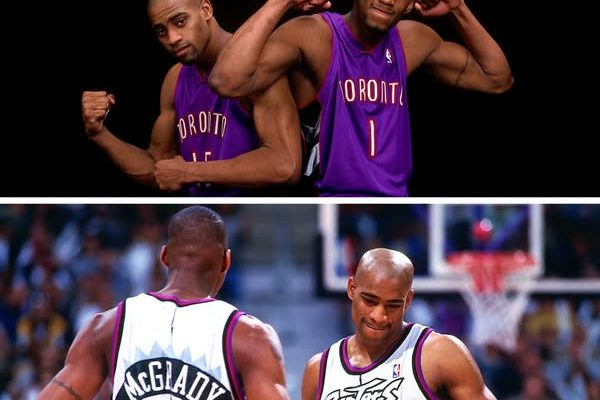In the pantheon of NBA “what ifs,” few scenarios spark as much intrigue as the partnership between Tracy McGrady and Vince Carter. The two high-flying, electrifying talents were teammates for just three seasons with the Toronto Raptors (1998-2000), a period that offered glimpses of their potential but ultimately left fans yearning for more. Had they stayed together longer, McGrady and Carter could have cemented themselves as one of the greatest duos in NBA history—rivaling the likes of Jordan-Pippen, Shaq-Kobe, and Stockton-Malone. Their individual brilliance, complementary skill sets, and sheer star power suggest that an extended partnership would have reshaped the league’s landscape in the 2000s.
The Early Years: A Glimpse of Greatness
When the Raptors drafted Vince Carter fifth overall in 1998 and paired him with his cousin Tracy McGrady (who had been acquired in a draft-night trade the previous year), Toronto unknowingly assembled one of the most dynamic young wing combinations in NBA history. Carter, the explosive dunker and scoring machine, quickly became the face of the franchise, while McGrady, still raw but brimming with potential, served as his understudy.
Their chemistry was undeniable. Both possessed rare athleticism, scoring versatility, and playmaking ability that made them nearly unguardable in transition. In the 1999-2000 season, Carter averaged 25.7 points per game, earning All-NBA honors, while McGrady, coming off the bench, showcased flashes of his future superstardom with 15.4 points, 6.3 rebounds, and 3.3 assists per game. The Raptors improved significantly, but their playoff run ended in a first-round sweep at the hands of the Knicks. Still, the foundation was laid for something special.
The Split: A Franchise-Altering Mistake
The Raptors’ biggest mistake was failing to recognize McGrady’s trajectory. Feeling overshadowed by Carter and seeking a larger role, McGrady left in the 2000 offseason, signing a lucrative deal with the Orlando Magic. Almost immediately, he blossomed into a perennial MVP candidate, averaging 26.8 points, 7.5 rebounds, and 4.6 assists in his first season in Orlando. Meanwhile, Carter continued to dominate in Toronto, peaking with a 27.6-point-per-game average in 2000-01.
Had Toronto retained McGrady, the duo would have entered their primes together—both as top-10 players in the league. Carter’s scoring prowess and McGrady’s all-around brilliance would have given the Raptors two elite shot creators, something only a handful of teams could boast at the time. Instead, Toronto struggled to build a contender around Carter alone, while McGrady carried Orlando to playoff appearances but lacked the supporting cast to make a deep run.
What made McGrady and Carter such a tantalizing pairing was how seamlessly their skills meshed. Carter was the alpha scorer—a relentless attacker with deep range, an unstoppable mid-range game, and the ability to take over games with his sheer offensive firepower. McGrady, meanwhile, was the more complete player—a 6’8″ point-forward with elite court vision, defensive versatility, and a smooth, effortless scoring ability.
Defensively, they would have been a nightmare. McGrady’s length and instincts allowed him to guard multiple positions, while Carter, when engaged, was a capable defender with explosive shot-blocking ability for a guard. Together, they could have locked down opposing wings and disrupted offenses at an elite level.
Offensively, their games would have forced defenses into impossible choices. Double-teaming Carter would leave McGrady with mismatches, and vice versa. Both were exceptional passers, making them a pick-and-roll nightmare. Imagine Carter as the roll man with McGrady as the ball-handler—a combination that would have been nearly unguardable given their size, athleticism, and shooting ability.



